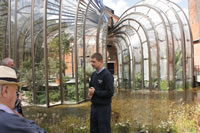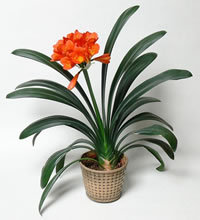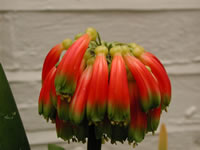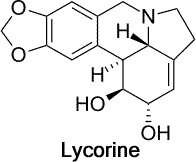1 Feb 2016
This month we are launching our search for this year's winners of the David Miller Travel Bursary Award. Thanks to continuing support from Vitacress and The Eden Project and the help of a new sponsor, The Eric Gardener Memorial Fund, we will be able to offer two awards of £500 each this year. Applications are invited from students in the second or final year of a higher education qualification (BSc, HND, Kew Diploma etc) or studying for an MSc or PhD. Applicants must be students registered for courses in the UK or the Republic of Ireland. Application close on 18 April 2016. Go to our web page for full details.
February also starts our season of events with the now regular PHGSW Cannington Conference. This years conference is being held on 11 February and is entitled 'Growing Media'. Speakers will include; Michael Pollock, Former Director of Rosewarne EHS and Head of Education at the RHS; Catherine Dawson, Technical Director of Melcourt the UK's leading supplier of mulches, growing media based on bark; and Chris Trimmer, Nursery Manager at the National Trust Plant Conservation Centre where the Trust propagates rare and historical plants for its gardens.
In March PHGSW are organising their usual three day meeting in the depths of the south-west. This years meeting based around Redruth, St Mawes and Mevagissey is on18 - 20 March.
Peter Grimbly
Contents
The Botany of Gin
Plant of the Month
News from our Associates
Horticulture Industry News
Events Calendar
Horticulture Group contact details
Related Links
The Botany of Gin
Last summer we visited Laverstoke Mill along with members of the Professional Horticulture Group South West. Laverstoke Mill lies in the valley of the river Itchen, the original source of power for the mill. While it may have began its life milling flour from the 18th century it was a paper mill owned by the Portal family producing the finest quality of paper. So fine, in fact, that it became the accepted paper for banknotes. Portals was eventually acquired by De la Rue and the print works relocated a few miles further up the valley. The derelict mill was eventually bought by Bombay Sapphire, part of the Bermuda based Bacardi Group, to distil its well-known gin.

Jenever came to England along with William of Orange and soon became very popular, perhaps too popular as depicted by Hogarth in his famous illustration of ‘Gin Lane’ (right). Today gin is seldom consumed neat and more commonly used as a mixer in well known cocktails such as;
• Pink gin, Plymouth Gin and Angostura bitters used by the navy to quell seasickness;
• Gin and Tonic, used by the East India company to make the malaria antidote quinine palatable;
• Dry Martini, gin and vermouth, shaken of course not stirred!
Today gin is a double distilled spirit flavoured with a variety of herbs and spices called ‘botanicals’ although the flavour of juniper must still predominate. Bombay Sapphire are proud of the fact that their standard product contains ten such botanicals although they have just released a new product with twelve.

These botanicals included;
Juniper, Juniperus communis
The essential ingredient. Originally used partly for its flavour and partly for its medicinal properties. The 17th Century herbalist physician, Nicholas Culpeper, recommended the ripened berries for conditions such as asthma and sciatica, as well as to speed childbirth (or abortion!).
Lemon Peel, Citrus limonum
Hand peeled lemons hung to dry in the Mediterranean air bring citrus flavours and help to lift the other botanical notes.
Grains of Paradise, Aframomum melegueta
A relative of the ginger plant from the moist coastal areas of West Africa, these seeds offer a spectrum of exotic flavours from a strong peppery bite with hints of citrus and light lavender notes.
Coriander, Coriandrum sativum
To some people coriander gives a flavour of citrus and warm ginger tastes. These tastes come from a mixture of aldehydes in the seeds. Unfortunately a significant proportion of the population carry a variant of the olfactory gene OR6A2 that seems to enhance the ability to detect the unpleasant soapy flavours of the unsaturated aldehydes in the mixture while stopping the ability to detect the more pleasant flavours of the saturated aldehydes.
Cubeb or Java Pepper Berries, Piper cubeba
A member of the pepper family from Java where it grows in the shade of coffee trees. The seeds contain a mixture of monoterpenes, sesquiterpines and eucalyptol which provide spicy flavours. In addition there is the alcohol cubebol which gives a cooling refreshing taste making it a popular component of toothpaste.
Orris Root, Iris x germanica
Orris root comes from a variety of the hybrid tetraploid Iris germanica. It contains myristic acid, a major constituent of nutmeg, Myristica fragrans, and also found in the spermaceti from sperm whales.
Almonds, Prunus amygdalus var. Amara
This bitter almond differs from the sweet almond Prunus amygdalus var. Dulcis by a single recessive allele which promotes the production of benzaldehyde, the chemical causing the bitter flavour. They also contain over forty times the quantity of hydrogen cyanide found in sweet almonds although there is no danger of dying from a few measures of gin.
Cassia Bark, Cinnamomum cassia
While true cinnamon comes from the Sri Lankan tree Cinnamomum verum, most cinnamon comes from the bark of other related species. The Chinese cinnamon Cinnamonum cassia is said to have a more delicate flavour.
Liquorice, Glycyrrhiza glabra
Liquorice provides a warm and sweet flavour to the gin. The sweetness comes from glycyrrhizin, a saponin with a sweetness some 30 – 50 times sweeter than sugar.
Angelica, Angelica archangelica
The root of the angelica plant contains numerous flavours, some complimenting other botanicals but also adding tastes of various coumarins.
These ten botanicals are carefully laid in special wire mesh baskets through which the distilled spirit is allowed to percolate. Some flavour elements dissolve out quickly while others take their time and it is part of the distillers art to determine the time when all the desired components have been dissolved to give the final desired flavour.
Plant of the Month
Clivia miniata, Kaffir Lily, Clivia, Amaryllidaceae
Following on from last month, here we take a look at another plant in the Amaryllidaceae, also typically grown as a houseplant in the UK.

Clivia is a genus of 6 species, all originating only from South Africa. The other species are: C. caulescens, C. gardenia, C. mirabilis, C. nobilis and C. robusta. C. mirabilis was named in 2000 and C. robusta in 2004, showing the importance of continued taxonomic research.
The genus was named by British botanist James Lindley for Lady Charlotte Florentina Clive, Duchess of Northumberland (1787-1866), one-time governess of the future Queen Victoria. The Duchess of Northumberland was the first person reported to flower clivia in cultivation.
The survival of all four species of Clivia in the wild is in question. The South African National Biodiversity Institute (SANBI) lists five out of the six species as Vulnerable (to extinction in the wild). The main threats are from over-collection for the horticultural trade and the medicinal plant trade, together with habitat destruction caused by coastal development or run off of nitrogenous fertilisers from nearby agricultural land.
Clivia miniata has been used widely in traditional medicine in South Africa although its use is definitely not to be recommended as the plant contains significant quantities of extremely toxic alkaloids including lycorine. That said, the traditional uses include treating fever (rhizome), helping with childbirth and hastening parturition (whole plant) and as a snake-bite remedy (rhizome). Lycorine is structurally related to galanthamine (see January 2016 Plant of the Month) and is also found in other genera in the Amaryllidaceae including Narcissus. Poisoning by lycorine will induce vomiting, diarrhoea and convulsions as more than one person who has accidentally eaten narcissus bulbs or drunk water in which cut daffodils have stood will testify.

A great plant to grow indoors just as long as you refrain from eating it!
Alison Foster
Royal Botanic Gardens Kew
News from our Associates

CHA will be leading the UK participation at the world’s most important events in commercial horticulture, including IPM Essen 2016, Fruit Logistica 2016 and GreenTech Amsterdam. Their next event is Fruit Logistica in Berlin on 3 - 5 February. Working alogside AHDB, CHA will host a British pavilion showcasing the latest innovations and research from the commercial horticultural industry, including developments in crop protection, pest and disease monitoring and control, substrates, fertilisers and postharvest technology amongst other areas. Anyone interested in exhibiting should contact CHA.

The Royal Society of Biology has responded to the Business, Innovation and Skills Committee green paper: Higher education: teaching excellence, social mobility and student choice. While supporting much of the consultation they have opposed the introduction of financial incentives whereby institutions achieving higher TEF levels are permitted to raise fees to a higher capped level. They have also expressed concern over the administrative burden created by the proposals and the metrics suggested to measure teaching excellence. The full response can be read here.

The Federations annual conference will take place at the John Innes Centre, Norwich on 11 -12 April 2016. Enitled 'Plants in a changing world: molecule to ecosystem'. The meeting will host a diverse range of talks, all held in plenary sessions and pitched towards a general plant science audience.
Horticulture Industry News
For the very latest horticultural news follow us on Facebook,
Twitter, or
LinkedIn
All change at JHSB
The Journal of Horticultural Science and Biotechnology (JHSB) has a new editor, Professor Brian Thomas of Warwick University, who takes over from Dr Michael Wilson. From January JHSB will be published by Abingdon based publisher Taylor & Francis a major publisher of scientific journals. The latest issues can now be found on the Taylor & Francis website. More
E. coli can grab hold of fresh veg
Between 20-30% of food-poisoning outbreaks are caused by people eating contaminated vegetables. New research shows that the disease-causing E. coli O157:H7 interacts directly with plant cells, allowing it to anchor to the surface of a plant, where it can multiply. The scientists have identified that E. coli O157:H7 uses its flagella to penetrate the plant cell walls. The team showed that purified flagella were able to directly interact with lipid molecules found in the membranes of plant cells. E. coli bacteria lacking flagella were unable to bind to the plant cells. Once attached, the E. coli are able to grow on, and colonise, the surface of the plant. At this point, they can be removed by washing, although the researchers showed that a small number of bacteria are able to invade inside the plant, where they become protected from washing.
Philippines bananas hit by double whammy
The Philippines’ billion-dollar banana industry is losing plantations to disease and extreme weather, according to trade figures. The Pilipino Banana Growers and Exporters Association (PBGEA) reported a loss of over 2,000ha in Mindanao during 2015, which represents 5.1 per cent of total banana acreage in the key growing region. Banana growers have suffered losses from Panama disease (Fusarium oxysporum), as well as from the devastating effects of the El Niño weather pattern. Mindanao’s banana acreage fell from 44,479.65ha in 2014 to 42,316.41ha in 2015 as a result, he said. Production volumes also dropped between January and September 2015 to 85,324,491 boxes, compared with 90,147,480 boxes for the prior year period. More
Dandelion latex deters cockchafers
Researchers have demonstrated that a single compound in the latex of dandelion (Taraxacum officinale) protects its roots against voracious cockchafer larvae, Melolontha melolontha. An analysis of the components of dandelion latex revealed that one single substance negatively influenced the growth of cockchafer larvae. This substance was identified as the sesquiterpene lactone, taraxinic acid ß-D-glucopyranosyl ester (TA-G). When the purified substance was added to an artificial larval diet in ecologically relevant amounts, the grubs fed considerably less. The researchers were also able to engineer plants with lower TA-G. Roots of engineered plants with less TA-G were considerably more attacked by cockchafer larvae. More
Lasers help antibiotics penetrate leaves
Florida's citrus industry has been struggling for nearly a decade with citrus greening, also known as Huanglongbing (HLB), a disease caused by a motile bacterium, Candidatus Liberibacter, that destroys fruit production and eventually kills the tree. A group of researchers has taken a new approach to the disease by studying a unique application of lasers on citrus leaves. They have found that lasers, when used with the right settings, could greatly improve the success of antibiotic treatments currently being looked into as a way to stop the deadliest plant disease in Florida's history. The disease kills trees from the inside out and the laser helps the antibiotic penetrate the protective epidermis and reach the seat of infection.
New strategy for Animal and Plant Health Research published
BBSRC has published, on behalf of a partnership of key UK research funders and policy makers, a vision and high level research strategy for UK Animal and Plant Health Research to 2020 and beyond. This new research vision and high level strategy has been developed, with leadership from BBSRC, as an early action towards delivering a joined up approach. It sets out a high level research strategy for key public research funders working within a new UK Science Partnership for Animal and Plant Health, and with wider research stakeholders.
A blow to Somerset cider
One of the biggest cider makers in the country is moving its cider making operation out of its traditional home in Somerset and over the sea to Ireland. Gaymers and Blackthorn ciders have until now been produced in Shepton Mallet's cider mill. Now C&C, which owns the mill wants to move production of cider to its Magners plant in Clonmel in Tipperary. Fruit would continue to be pulped at the Shepton Mallet plant, but it would then be shipped to Clonmel, where all its cider will be produced. The mill is expected to close in July or late summer 2016 but the company said it will continue to source apples from local farmers.
Newly Identified Enzyme May Be the Culprit in Pierce’s Disease Grapevine Damage
It’s been known for a number of years that when Xyllela fastidiosa invades a grapevine, it produces a biofilm or gel in the xylem. Scientists have theorized that this biofilm damages the vine by clogging up the xylem, preventing the flow of water to the leaves. But not all of the evidence stacked up to fit that theory. Now a research team has been analyzing the bacteria’s secretome — the entire collection of enzymes and other proteins secreted by a disease-causing agent like Xyllela fastidiosa during the infection process. Such secreted proteins are known to play key roles in triggering many plant diseases. The resulting data indicated that an enzyme, which the researchers named LesA, was quite abundant during Xyllela fastidiosa infections and shared characteristics with similar enzymes known to be capable of breaking down plant cell walls. They went on to confirm their suspicions by demonstrating that a mutant strain of Xyllela fastidiosa bacteria — with a specific gene knocked out, or inactivated — lacked the ability to cause infection in grapevines. More
Events Calendar
Other Events of Interest:
Plant Genetics and Breeding Technologies
1 - 2 Feb 2016, VISCEA
Vienna, Austria
UK Grower Awards
3 Feb 2016, Horticulture Week
London, UK
Fruit Logistica
3 - 5 Feb 2016
Berlin, Germany
Plant Model Species: Fundamentals and Applicatiions
4 - 5 Feb 2016, VISCEA
Vienna Austria
Plants In Vitro: Theory and Practice
8 - 9 Feb 2016, VISCEA
Vienna, Austria
Plant Genes and "Omics": Technology Development
11 - 12 Feb 2016, VISCEA
Vienna, Austria
Salon du Vegetal
16 - 18 Feb 2016
Tree and Plant Health Early Warning Systems in Europe
23 - 24 Feb 2016, Observatree
Kew, UK
Environmental Management & Crop Protection
23 - 24 Feb 2016, Association for Crop Protection in Northern Britain
Dundee, UK
Contested Agronomy: whose agronomy counts?
23 - 25 Feb 2016, Institute of Development Studies
Brighton, UK
Plant Resistance to Insects Symposium
5 - 8 Mar 2016
Stellenbosch, South Africa
Processing Tomato Congress
6 - 9 Mar 2016, International Society for Horticultural Science
Santiago, Chile
Tropical and Subtropical Ornamentals
7 - 9 Mar 2015, International Society for Horticultural Science
Krabi Province, Thailand
Plant Breeding Symposium: 'Back to the Phenotype'
8 - 10 Mar 2016, South African Plant Breeding Association
Stellenbosch, South Africa
In Vitro Culture and Horticultural Breeding
13 - 15 Mar 2015, International Society for Horticultural Science
Giza, Egypt
Sexual Plant Reproduction
18 - 23 Mar 2016
Tucson, USA
Horticulture Group Contact Details
For submitting ideas or to volunteer to be part of a committee or a group, please contact:
Chairman - Tony Girard
Meetings Coordinator - Peter Grimbly
Minutes Secretary - Margaret Waddy
Newsletter co-ordinator - Sue Grimbly scihortigroup@btinternet.com

